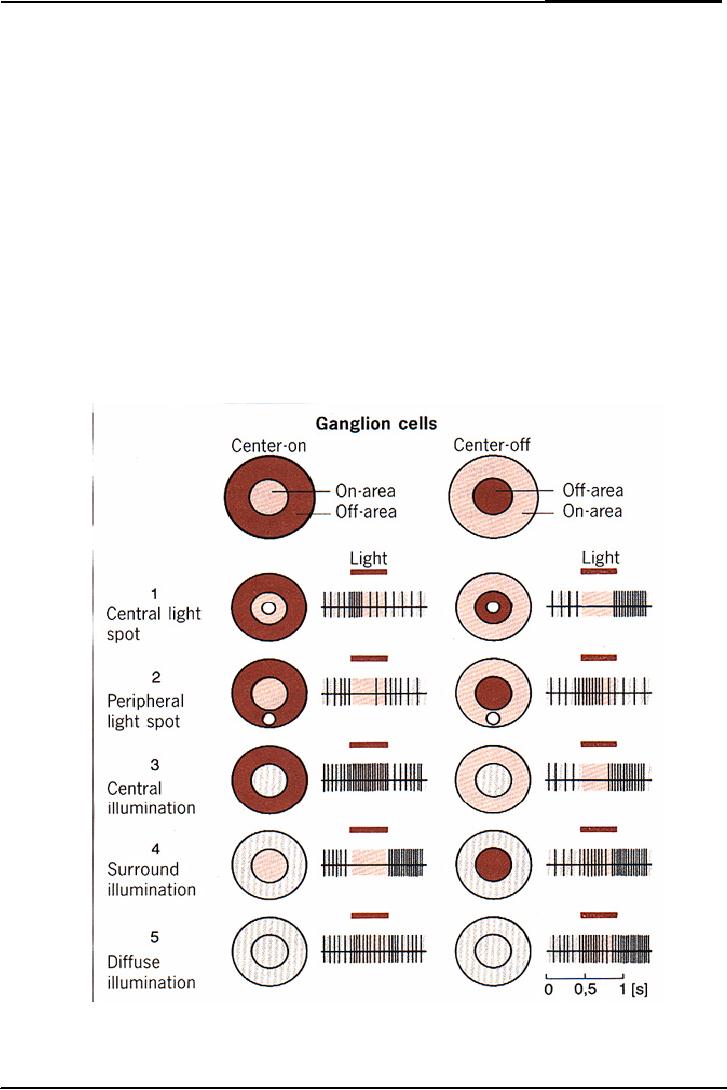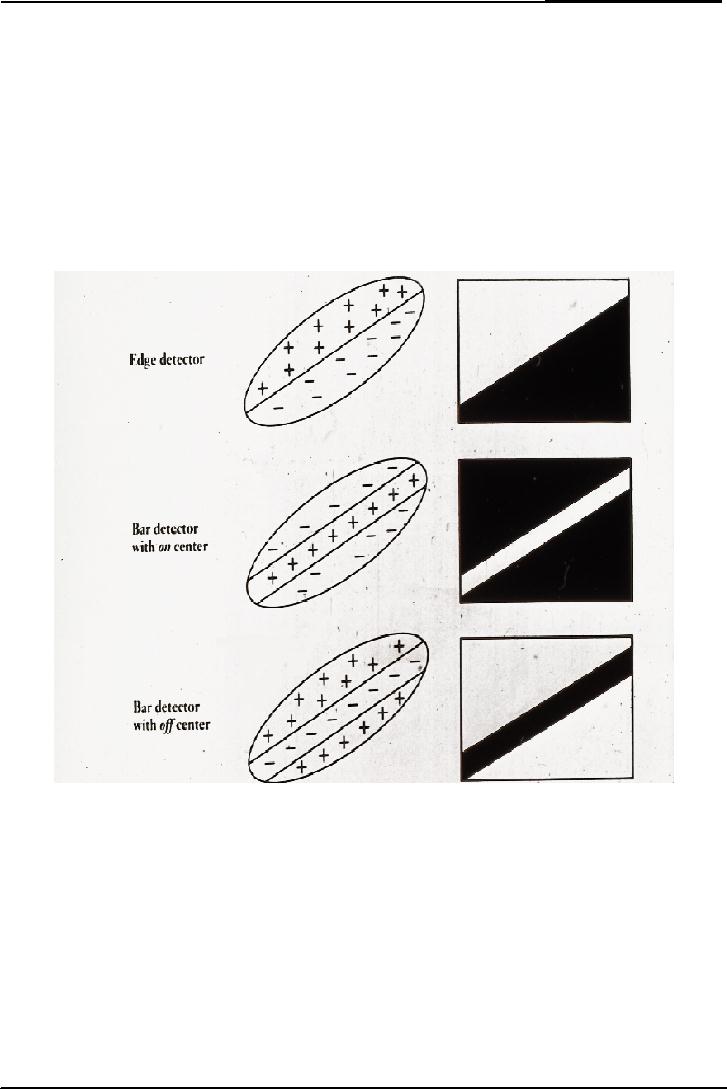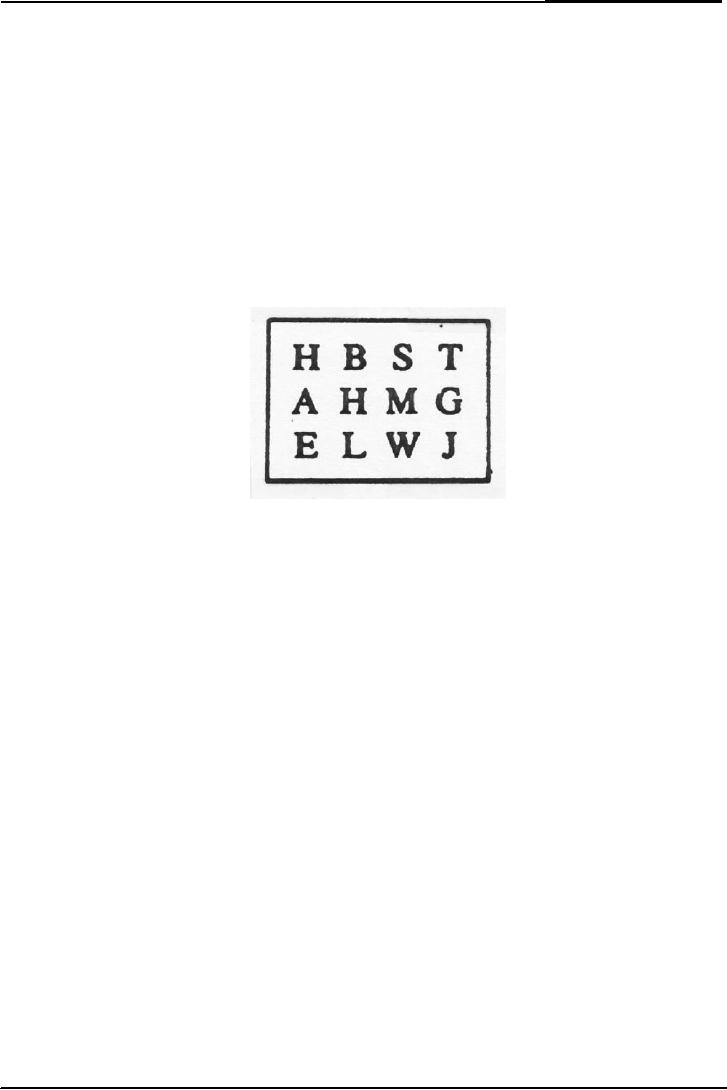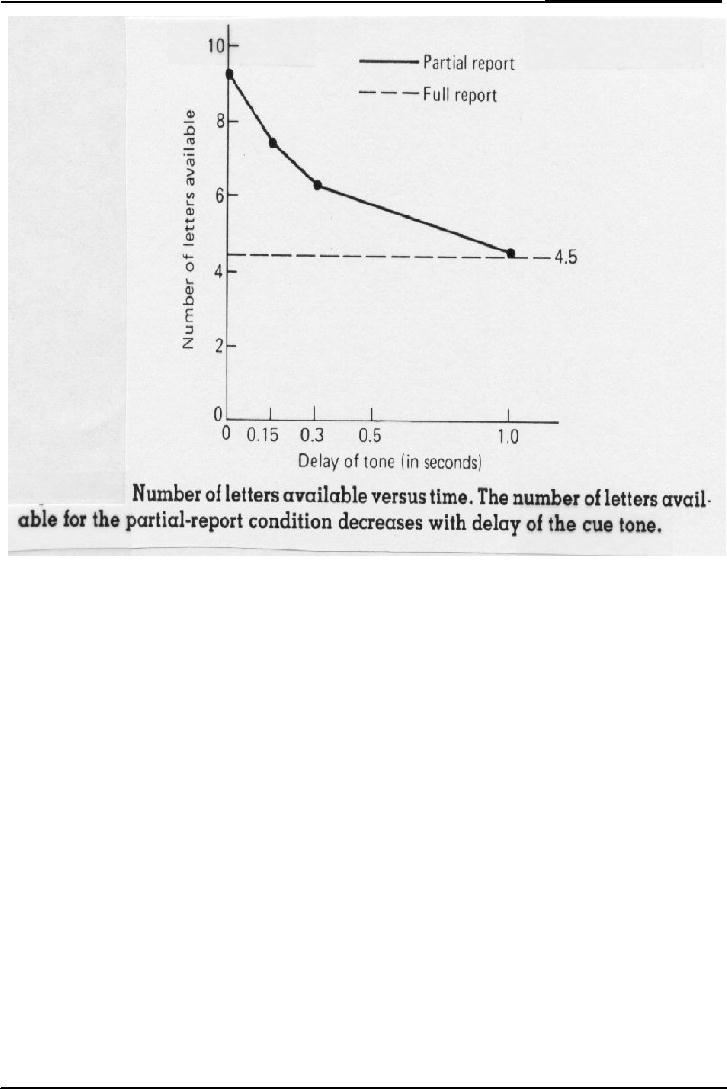 |

Cognitive
Psychology PSY 504
VU
Lesson
05
COGNITIVE
PSYCHOLOGY (CONTINUED)
Information
Processing in Visual
Cells
Information
processing (of visual
information) is done in our
visual cortex. Different
classical
experiments
were conducted to understand
how do sensation transform
into perception? One
experiment
was conducted by Kuffler in
1953. Kuffler studied
ganglion cells in order
to
understand
how sensation transforms
into perception and he
discovered on-off and
off-on
cells.
These cells define visual
information processing. If the
light fell on the centre of
retina,
on-off
cells were activated, if the
light fell on the periphery,
off-on cells start firing.
In figure of
Ganglion
cells there are on-off
cells on the left side. On
right side there are
off-on cells. Lines
indicate
the activation of neuron and
it also indicating the
generation of electrical
impulses.
When
light fells on centre of
retina the on-off cells
start firing. When light
fells on peripheral
on-off
cells are not firing. At
this point off-on cells
activate. When light is on
centre on-off cells
work
and off-on cells do not
work. When there is
illumination on surrounding point
on-off cells
become
silent and off-cells start
work. When there is diffuse
illumination both cells
firing
slowly.
This all is happening at
ganglion cells level. Before
going visual cortex, the
visual
system
has started processing. The
ganglion cells processing is
given in following
figure.
10

Cognitive
Psychology PSY 504
VU
Hubel
& Wiesel
Another
important experiment was
conducted by Hubel & Wiesel in
1962. They started
their
experiment
with cats. They used
visual cortex of the cat.
They showed different
stimuli, lights
and
shapes to cats and then
they viewed cortical cells
are more complex. They
found that
visual
cortical cells responded in a
more complex manner than
lower cells. They named
those
cells
bar detectors and edge
detectors.
Edge
detectors help us to understand
where an object ends and
other starts. Edge
detectors
respond
positively to light on one
side of line and negatively
to light on the other side.
And Bar
detectors
respond positively to light in
the center and negatively to
light at the periphery,
or
vice
versa. Both bars and
edges detectors are specific
with respect to position,
orientation,
and
width. That is, they
respond only to stimulation in a
small area of visual field.
Bar and
Edge
detectors combine to see a
lot of objects as shown in
the figure.
David
Marr's Work
The
David Marr developed a
computer model of how
information from the on and
off cells
could
be used to yield a useful
analysis of the visual
image. He developed a model in
which
computer
like human beings assimilate
on-off cells.
Marr
and Hildreth (1980) combined
the output of off-on
detectors to calculate bars
and edges of
various
widths and
orientations.
In
computer system symbolic
descriptions were created.
Boundaries of objects in the
real images
pose
a difficult problem in computer
vision. This system combines
the symbolic description
to
identify
the contour of an
object.
11

Cognitive
Psychology PSY 504
VU
The
following picture is showing
different things grass,
colorful clouds etc. Human
mind detect
different
things. Like human mind
this computer is made to
understand different boundaries
of
image.
Sensory
Memory
When
information first enters the
human system, it is registered in
sensory memories.
Sensory
memory allows us to take a
snapshot of our environment,
and to store this
information
for
a short period. Only
information that is transferred to
the other level of memory
will be
preserved
no more than for a two
seconds. Sensory memory
holds a short impression of
sensory
information
even then the sensory
system does not send
any information anymore.
There are 5
basic
senses. These are:
1.
Vision
2.
Hearing
Most
of the work has focused on
vision and hearing. This is
because technology is
also
quite
advance in hearing and
vision like camera,
microphone and computers
etc.
Computer
can receive voice command
and also can produce
speech.
The
others are:
12

Cognitive
Psychology PSY 504
VU
3.
Smell
4.
Taste
5.
Touch
Visual
Sensory Memory
Iconic
Memory
It
can store a great deal of
memory only for a very
brief period of time. In
human experimentation,
the
subject is made to sit and
is asked to look at a screen, a
computer screen normally. A
dot is
shown
on the screen with blank
white screen (do is located
in the center) and the
subject is asked
to
focus on the dot. Instead of
dot, a set of letter is
presented at that fixed
point, where the
subject
is
focusing. After a very brief
period letters (stimuli) are
removed.
Subjects
are asked to report items.
Subjects normally reported
only 4-5 items out of 12
letters.
The
set of stimuli is
following
Sperling's
partial report
procedure
An
experiment was conducted by
Sperling in the field of
visual sensory memory. In
that
experiment
the same array of letter
was presented to the
subjects but the subjects
were
asked
to report the letters
according to the cue (a beep
in this case an auditory
cue). After
the
array was turned off, a
tune was sounded high,
medium or low.
High
tone cue for reporting
the top row
Medium
tone cue for middle
row
Low
tone cue for Bottom
row
Better
performance
High
tone HBST (subject to
report the first
row)
Medium
tone AHMG (subject to report
the second row)
Low
tone ELWJ (subject to
report the third
row)
13

Cognitive
Psychology PSY 504
VU
Subjects
reported at least 3 out of 4
letters, no matter whether it
was on top row or middle
row or
bottom
row. It was very
significant. Because the
subject did not know
beforehand which row
will
be
cued, they had to have
three letters from each
row available to them. So
they had at least 9
out
of 12 letters available in their
visual memory
Sperling's
method was called the
partial-report procedure.
The
decay in visual
memory
Sperling
also varied the length of
the delay between the
offset of the display and
the tone. As the
delay
increases to 1 second, subjects'
performance decays back to
the original whole-report
level
of
4 or 5 items. As the graph is
showing. It indicates our
visual memory lose most of
the
information
in one second.
The
decay in visual
memory
.
14

Cognitive
Psychology PSY 504
VU
The
criticism on this experiment
was that it is an artificial or
laboratory phenomenon. It is
not
related
to real life vision.
Sperling's
experiments indicate the
existence of a brief visual
sensory store- a memory that
can
effectively
hold all the information in
the visual display. We
receive a lot of visual
information from
our
surrounding but this all
store in our visual sensory
memory for a very brief
period. That
information
receives attention, stored in
our memory other is
lost.
15
Table of Contents:
- INTRODUCTION:Historical Background
- THE INFORMATION PROCESSING APPROACH
- COGNITIVE NEUROPSYCHOLOGY:Brains of Dead People, The Neuron
- COGNITIVE NEUROPSYCHOLOGY (CONTINUED):The Eye, The visual pathway
- COGNITIVE PSYCHOLOGY (CONTINUED):Hubel & Wiesel, Sensory Memory
- VISUAL SENSORY MEMORY EXPERIMENTS (CONTINUED):Psychological Time
- ATTENTION:Single-mindedness, In Shadowing Paradigm, Attention and meaning
- ATTENTION (continued):Implications, Treismanís Model, Normanís Model
- ATTENTION (continued):Capacity Models, Arousal, Multimode Theory
- ATTENTION:Subsidiary Task, Capacity Theory, Reaction Time & Accuracy, Implications
- RECAP OF LAST LESSONS:AUTOMATICITY, Automatic Processing
- AUTOMATICITY (continued):Experiment, Implications, Task interference
- AUTOMATICITY (continued):Predicting flight performance, Thought suppression
- PATTERN RECOGNITION:Template Matching Models, Human flexibility
- PATTERN RECOGNITION:Implications, Phonemes, Voicing, Place of articulation
- PATTERN RECOGNITION (continued):Adaptation paradigm
- PATTERN RECOGNITION (continued):Gestalt Theory of Perception
- PATTERN RECOGNITION (continued):Queen Elizabethís vase, Palmer (1977)
- OBJECT PERCEPTION (continued):Segmentation, Recognition of object
- ATTENTION & PATTERN RECOGNITION:Word Superiority Effect
- PATTERN RECOGNITION (CONTINUED):Neural Networks, Patterns of connections
- PATTERN RECOGNITION (CONTINUED):Effects of Sentence Context
- MEMORY:Short Term Working Memory, Atkinson & Shiffrin Model
- MEMORY:Rate of forgetting, Size of memory set
- Memory:Activation in a network, Magic number 7, Chunking
- Memory:Chunking, Individual differences in chunking
- MEMORY:THE NATURE OF FORGETTING, Release from PI, Central Executive
- Memory:Atkinson & Shiffrin Model, Long Term Memory, Different kinds of LTM
- Memory:Spread of Activation, Associative Priming, Implications, More Priming
- Memory:Interference, The Critical Assumption, Limited capacity
- Memory:Interference, Historical Memories, Recall versus Recognition
- Memory:Are forgotten memories lost forever?
- Memory:Recognition of lost memories, Representation of knowledge
- Memory:Benefits of Categorization, Levels of Categories
- Memory:Prototype, Rosch and Colleagues, Experiments of Stephen Read
- Memory:Schema Theory, A European Solution, Generalization hierarchies
- Memory:Superset Schemas, Part hierarchy, Slots Have More Schemas
- MEMORY:Representation of knowledge (continued), Memory for stories
- Memory:Representation of knowledge, PQ4R Method, Elaboration
- Memory:Study Methods, Analyze Story Structure, Use Multiple Modalities
- Memory:Mental Imagery, More evidence, Kosslyn yet again, Image Comparison
- Mental Imagery:Eidetic Imagery, Eidetic Psychotherapy, Hot and cold imagery
- Language and thought:Productivity & Regularity, Linguistic Intuition
- Cognitive development:Assimilation, Accommodation, Stage Theory
- Cognitive Development:Gender Identity, Learning Mathematics, Sensory Memory